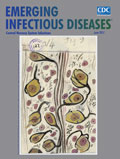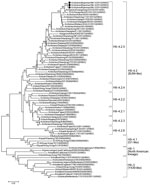
Volume 23, Number 6—June 2017
Research Letter
Influenza A(H9N2) Virus, Myanmar, 2014–2015
On This Page
Thant Nyi Lin, Nutthawan Nonthabenjawan, Supassama Chaiyawong, Napawan Bunpapong, Supanat Boonyapisitsopa, Taveesak Janetanakit, Pont Pont Mon, Hla Hla Mon, Kyaw Naing Oo, Sandi Myint Oo, Mar Mar Win, and Alongkorn Amonsin
Abstract
Routine surveillance of influenza A virus was conducted in Myanmar during 2014–2015. Influenza A(H9N2) virus was isolated in Shan State, upper Myanmar. Whole-genome sequencing showed that H9N2 virus from Myanmar was closely related to H9N2 virus of clade 4.2.5 from China.
Influenza A(H9N2) virus has been found in several avian species. Despite low pathogenicity in poultry, H9N2 viruses are important to public health because of their high adaptability and frequent infection in humans. Clinical cases of H9N2 human infection have been reported in China (including Hong Kong) and Bangladesh (1,2). H9N2 viruss are constantly evolving and can reassort with other influenza A virus subtypes, resulting in novel influenza viruses. H9N2 was the likely donor of internal genes for the H5N1, H7N9, and H10N8 viruses (3,4).
During December 2014–August 2015, we conducted an influenza A surveillance program in Shan State, Myanmar. An outbreak of highly infectious avian influenza A(H5N1) in November 2007 has been the only outbreak reported in this state. For this study, we collected 648 samples from live-bird markets (LBMs) in Muse, Namkham, Laukkai, and Chinshwehaw, Shan State townships on the China–Myanmar border (Technical Appendix[PDF - 1010 KB - 8 pages] Figure 1). We collected oropharygeal swab specimens from chickens (n = 273) and ducks (n = 180) as well as environmental samples (n = 195). Identification and isolation were performed at the Livestock Breeding and Veterinary Department, Yangon, Myanmar (Technical Appendix[PDF - 1010 KB - 8 pages]).
Of the 648 samples subjected to virus isolation by egg inoculation, 10 were hemagglutinin (HA) positive. We further confirmed 3 samples as influenza A virus by using real-time reverse transcription PCR (RT-PCR), and we subtyped and confirmed all 3 as H9N2 (Technical Appendix[PDF - 1010 KB - 8 pages]Table1). However, the overall occurrence of H9N2 in the LBMs in this study was relatively low. The 3 H9N2 isolates, A/chicken/Myanmar/NK-2/2015(H9N2), A/chicken/Myanmar/NK-4/2015(H9N2), and A/chicken/Myanmar/NK-5/2015(H9N2), were from chickens in LBMs in Namkham Township in June 2015.

Figure. Phylogenetic tree of H9 gene of influenza A(H9N2) viruses from Myanmar and reference viruses. Phylogenetic trees were constructed by using MEGA version 6.0 (http://www.megasoftware.net/) and a neighbor-joining algorithm with the...
To characterize the Myanmar H9N2 virus, we performed whole-genome sequencing of these 3 isolates and submitted nucleotide sequences GenBank (accession nos. KY115364–KY115387). Although an international standard for clade nomenclature of the H9 subtype has not been well established, phylogenetic analysis showed that all 3 Myanmar H9N2 isolates were grouped into clade 4.2.5 (HA gene) and BJ94-like (neuraminidase [NA] gene) (Figure; Technical Appendix[PDF - 1010 KB - 8 pages] Figure 2) (5). The Myanmar H9N2 viruses clustered with avian and human H9N2 virus recovered in China in 2015. The phylogenetic analyses of internal protein genes showed similar findings; the Myanmar H9N2 viruses were also closely related to avian H9N2 viruses from China. Five internal protein genes, polymerase basic protein 2 (PB2), polymerase basic protein 1 (PB1), polymerase acidic protein (PA), nucleoprotein (NP), and membrane protein (M), were grouped with the viruses of G1 lineage, and the nonstructural (NS) gene was grouped in BJ-94–like lineage (Technical Appendix[PDF - 1010 KB - 8 pages] Figure 3). In addition, BLAST analysis (https://blast.ncbi.nlm.nih.gov/Blast.cgi) of the 8 gene segments of the Myanmar H9N2 viruses showed high percentages of nucleotide identities with H9N2 viruses from China (Technical Appendix[PDF - 1010 KB - 8 pages] Table 2).
Genetic analysis showed that the Myanmar H9N2 viruses possessed R-S-S-R at the HA cleavage site, indicating low pathogenic characteristics (6). At the HA receptor binding sites, all Myanmar H9N2 isolates carried Q226L substitution, showing the affinity to human α-2,6-glycan receptors (7). The Myanmar H9N2 viruses possessed all 7 HA receptor binding sites, identical to human H9N2 virus A/Zhongshan/201501/2015 (Technical Appendix[PDF - 1010 KB - 8 pages] Table 3) (8). For NA gene analysis, all Myanmar H9N2 viruses had a 3-aa deletion (positions 62 to 64) in the NA stalk region, suggesting virus adaptation from wild birds to poultry (8).
Internal protein gene analysis showed that the Myanmar H9N2 isolates possessed both avian- and human-specific amino acids. For example, no mutation was observed at E627 and D701 in PB2, retaining the avian characteristics (9), whereas human-specific amino acids were observed at 13P in PB1 and 409N in PA (10). Amino acids concerning virulence of the H9N2 viruses were also indicated. For example, the PA gene carried 672L and the NS1 gene contained 149A, relating to increased virulence of the virus (10). All Myanmar H9N2 viruses also possessed 31N in the M2 gene, suggesting amantadine resistance. Our results, based on the whole-genome analysis, showed that the Myanmar H9N2 viruses possessed all genetic signatures and virulence determinants similar to avian and human H9N2 viruses circulating in China in 2015 (Technical Appendix[PDF - 1010 KB - 8 pages] Tables 3–5).
In conclusion, the Myanmar H9N2 viruses were considered of low pathogenicity in chickens. However, public health concerns should be raised because the viruses are closely related tom and possess virulence determinants similar to, human H9N2 reported in China in 2015. The human cases likely represent a spillover of the virus to humans from poultry (8). The Myanmar H9N2 viruses were obtained from healthy chickens in LBMs near the China–Myanmar border, where sources of poultry are mostly from China. Because LBMs are the major sources of several subtypes of influenza viruses, this environment provides opportunities for influenza viruses to mix, be transmitted, and exchange their gene segments. Infection and transmission in humans and poultry can frequently occur in LBM settings. Therefore, public awareness, control measures, and routine disease surveillance should be implemented.
Dr. Lin, a veterinarian, is a PhD candidate at the Center of Excellence for Emerging and Re-emerging Diseases in Animals, Faculty of Veterinary Science, Chulalongkorn University, Bangkok, Thailand. His research interests are molecular epidemiology of emerging infectious diseases, especially influenza, in animals.
Acknowledgment
This research was supported by the National Research University Fund (NRU59-028-HR) and the research chair grant NSTDA (P-15-50004). Chulalongkorn University provided financial support to the Center of Excellence for Emerging and Re-emerging Infectious Diseases in Animals and the graduate scholarship for Neighboring Countries to T.N.L. The Thailand Research Fund (TRF) provided financial support to the TRF Senior Scholar (RTA5780006) to A.A.
References
- Butt KM, Smith GJ, Chen H, Zhang LJ, Leung YH, Xu KM, et al. Human infection with an avian H9N2 influenza A virus in Hong Kong in 2003. J Clin Microbiol. 2005;43:5760–7. DOIPubMed
- Shanmuganatham K, Feeroz MM, Jones-Engel L, Smith GJ, Fourment M, Walker D, et al. Antigenic and molecular characterization of avian influenza A(H9N2) viruses, Bangladesh. Emerg Infect Dis. 2013;19:1393––1402. DOIPubMed
- Gao R, Cao B, Hu Y, Feng Z, Wang D, Hu W, et al. Human infection with a novel avian-origin influenza A (H7N9) virus. N Engl J Med. 2013;368:1888–97. DOIPubMed
- Zhang Y, Yin Y, Bi Y, Wang S, Xu S, Wang J, et al. Molecular and antigenic characterization of H9N2 avian influenza virus isolates from chicken flocks between 1998 and 2007 in China. Vet Microbiol. 2012;156:285–93. DOIPubMed
- Liu S, Ji K, Chen J, Tai D, Jiang W, Hou G, et al. Panorama phylogenetic diversity and distribution of Type A influenza virus. PLoS One. 2009;4:e5022. DOIPubMed
- Ge F-F, Zhou J-P, Liu J, Wang J, Zhang W-Y, Sheng L-P, et al. Genetic evolution of H9 subtype influenza viruses from live poultry markets in Shanghai, China. J Clin Microbiol. 2009;47:3294–300.
- Matrosovich MN, Krauss S, Webster RG. H9N2 influenza A viruses from poultry in Asia have human virus-like receptor specificity. Virology. 2001;281:156–62. DOIPubMed
- Zhao Y, Li S, Zhou Y, Song W, Tang Y, Pang Q, et al. Phylogenetic analysis of hemagglutinin genes of H9N2 avian influenza viruses isolated from chickens in Shandong, China, between 1998 and 2013. BioMed Res Int. 2015;2015:267520.
- Yuan J, Xu L, Bao L, Yao Y, Deng W, Li F, et al. Characterization of an H9N2 avian influenza virus from a Fringilla montifringilla brambling in northern China. Virology. 2015;476:289–97. DOIPubMed
- Kandeil A, El-Shesheny R, Maatouq AM, Moatasim Y, Shehata MM, Bagato O, et al. Genetic and antigenic evolution of H9N2 avian influenza viruses circulating in Egypt between 2011 and 2013. Arch Virol. 2014;159:2861–76. DOIPubMed






















.png)












No hay comentarios:
Publicar un comentario